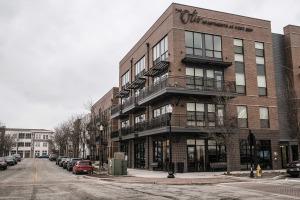Editorial: Downtown heliport is an asset that may prove worth keeping
Experts in the field say the downtown heliport is just the kind of property other cities will be trying to create as advanced aviation technology matures.
Experts in the field say the downtown heliport is just the kind of property other cities will be trying to create as advanced aviation technology matures.

The Hogsett administration told IBJ it now plans to conduct an analysis to determine the benefits and challenges of the 4.9-acre site.

In downtown Indianapolis, where train lines hug the eastern and southern boundaries of the city’s Mile Square, a hazardous spill evacuation could affect more than 100,000 people—including office workers, residents, business owners and visitors, depending on the time of day.

The number of people renting in downtown’s 46204 ZIP code doubled to 5,500 from 2011 to 2020, according to a recent study from California-based market researcher RentCafe.

Mason King talks with Greg Harris, founder of Backhaul Direct, which left downtown, and Andrew Elsenser, co-founder of Spot, which is expanding downtown.
IBJ received nearly 2,000 responses to a survey asking questions about downtown. The results aren’t scientific but they are interesting.
For the Feb. 17 issues of IBJ, staff photographers and freelancers took to the streets (and the air) to photograph the central city.

If downtown’s pandemic recovery had a report card, its tourism grade would be a B. And that’s not a subjective assessment. It’s based on newly released 2022 convention and tourism data.

Indianapolis plans to pilot a low-barrier shelter on city-owned property and create a master leasing program in which the city would lease units on behalf of property owners to low- or no-income individuals.

“My business model completely changed,” said Downtown Comics owner Doug Stephenson of the Market Street store. “If you look at my sales chart, everything moved from Wednesday, which is traditionally the biggest day for comic stores … to the weekends.”

Loree Everette’s biggest concern about downtown has nothing to do with the typical complaints involving homelessness, safety or cleanliness. It’s that living downtown has become so popular it’s unaffordable for too many people.

Many parts of downtown are thriving—particularly neighborhoods, where rents are rising, people have to stand in line for a lunch table, and investments are flowing. Other parts—especially downtown’s central core, where many workers might come to the office only once or twice a week—are limping along, pockmarked by vacant storefronts, panhandlers and crumbling sidewalks.

Nearly 29,000 residents now live downtown, up from about 15,000 in 2010. It’s a number that has been growing as developers continue to add apartment and condo units in the Mile Square and downtown neighborhoods.

While the state and the city have come together on major downtown projects over the years, there’s sometimes tension between what Indianapolis officials would like to see from the state and how the state views its responsibility to the capital city.

Cummins, Rolls-Royce, Eli Lilly and Co., AES and Elevance Health are among the city’s largest downtown employers and all say most of their workers have the option of working at home at least part of the time.
As state and city leaders grapple with reinvigorating downtown and contemplate the future economic drivers for the region, arguably nothing holds more promise than the further activation of two of the state’s most powerful research engines.
We have begun transforming underutilized city-owned properties into mixed-use residential hubs. That added housing comes alongside other major residential projects and will be surrounded by infrastructure that improves mobility for residents with or without a car.
The Indy Chamber has a central role activating the regional business community, collaborating with elected officials and not-for-profit partners, and mobilizing resources toward strategic, long-term solutions. We embrace these responsibilities.
We need a return to the type of civic responsibility and corporate investment that rebuilt Monument Circle, re-envisioned Circle Centre, and empowered employees to get involved in the downtown civic ecosystem.
It will take a collaborative effort from city officials, public safety, business owners and creatives to provide access to small-business owners and investors like myself who want to grow downtown and move forward, together.